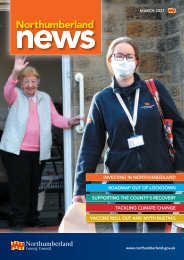Climate change action plan 2021-23
Climate change action plan 2021-23
Climate change action plan 2021-23
Create successful ePaper yourself
Turn your PDF publications into a flip-book with our unique Google optimized e-Paper software.
Heat reduction<br />
In order to maximise both the cost and carbon efficiency<br />
of Northumberland’s building stock, starting with a<br />
“fabric first” approach is key. This means utilising the<br />
most modern insulation techniques and applying<br />
these with confidence in their most appropriate<br />
settings. Due to the diverse portfolio of properties,<br />
there is no “one size fits all” approach and hence<br />
bespoke options will be required to be delivered.<br />
Properties may be broken into certain archetypes<br />
which allows for certain measures to be replicated in<br />
large numbers, for instance those with cavities should<br />
have cavity wall insulation and all properties which<br />
have an unused loft space (i.e. no room in roof)<br />
should have 300mm of loft insulation applied (current<br />
standard). These measures have been supported<br />
through the government’s ECO programmes and<br />
Northumberland County Council will continue to<br />
promote and support the implementation to be<br />
funded through this and other supported<br />
mechanisms, where available.<br />
In order to maximise both the carbon reductions and<br />
the investment within the county Northumberland<br />
County Council will support engagement through<br />
two distinct angles;<br />
Domestic properties – support those who are<br />
eligible to apply for Green Homes Grant 7 funding<br />
and other support mechanisms such as Energy<br />
Company Obligation (ECO) 8 funding to facilitate<br />
economic investment in these technologies and<br />
encouraging the able to pay market to adopt these<br />
technologies as part of a carbon reduction strategy.<br />
Commercial properties - there are limited support<br />
mechanisms which are as wide reaching as Green<br />
Homes Grant for businesses, but support does exist<br />
through several agencies, such as North East LEP,<br />
North of Tyne Combined Authority and Borderlands.<br />
It will be for Northumberland County Council and<br />
our partners to support businesses to access<br />
relevant mechanisms and encourage them to<br />
adopt appropriate technologies themselves.<br />
Despite best intentions, there are fundamental<br />
challenges in improving the thermal efficiency of<br />
some properties, described generally as “hard to<br />
treat” these include single skin stone-built properties.<br />
Accurately identifying these properties and<br />
understanding what, if any, measures can be applied<br />
to support these properties is important. Without<br />
sufficient thermal improvements these properties will<br />
still rely on fossil fuels as a primary fuel source.<br />
Methods of decarbonising heat<br />
Renewable heating most efficiently runs at low<br />
temperatures (30-45°C) and hence thermal efficiency<br />
is key in maintaining comfortable heat levels within<br />
properties. To support this heat emitters often require<br />
increasing in size to provide sufficient energy at lower<br />
temperatures to heat room spaces. This can provide<br />
major disruption and inconvenience to people’s lives,<br />
reinforcing the requirement for up front engagement<br />
and support to assist understanding of the<br />
technologies to be implemented.<br />
As will be discussed in greater detail in the next<br />
section, a large part of the clean growth strategy<br />
outlined by BEIS is supporting low carbon district<br />
heat networks 9 . In order to meet the ambitious 2030<br />
target in a cost-effective way district heat networks<br />
will require wide roll out across urban areas. These<br />
networks may involve removing boilers from people’s<br />
home as they would become reliant on a centralised<br />
heat source providing heat directly to their<br />
properties. This is likely to be met with resistance and<br />
uncertainty until first adopters are receiving high<br />
quality service without issues.<br />
Other types of heating will involve properties having<br />
direct responsibility for their own heating source, be<br />
this a heat pump or other technology. This may be<br />
more palatable to end customers but is likely to suffer<br />
from lower efficiencies and higher end costs to some<br />
consumers. Promoting opportunities to understand<br />
the impacts of renewable heat and to access grants<br />
or loans will be a key part of our communications and<br />
engagement strategy.<br />
7<br />
https://www.gov.uk/guidance/apply-for-the-green-homes-grant-scheme<br />
8<br />
https://www.ofgem.gov.uk/environmental-programmes/eco<br />
9<br />
https://www.gov.uk/government/consultations/green-heat-network-fund-proposals-for-the-scheme-design<br />
26<br />
<strong>Climate</strong> Change Action Plan <strong>2021</strong>-<strong>23</strong>
















